Abstract
Traditional vector and raster spatial models as used in many computer systems are examined to determine what is meant by the term “neighbour”. The limitations are examined and the Voronoi spatial model is proposed as a consistent alternative to both. It is then asked whether this new computer model of space bears any resemblance to human spatial reasoning and perception processes. Examination of the work of Blum, Ahuja, Tuceryan, Serra and others suggests that the Voronoi model may indeed relate to visual perception and the concept of “neighbour”.
Preview
Unable to display preview. Download preview PDF.
References
N. Ahuja: Dot pattern processing using Voronoi neighbourhoods. IEEE Transactions on Pattern Analysis and Machine Intelligence PAMI-4, 336–343 (1982).
N. Ahuja, M. Tuceryan: Extraction of early perceptual structure in dot patterns: integrating region, boundary and component Gestalt. Computer Vision, Graphics and Image Processing 48, 304–356 (1989).
F. Aurenhammer: Voronoi diagrams — a survey of a fundamental geometric data structure. ACM Computing Surveys 23, 345–405 (1991).
H. Blum: A transformation for extracting new descriptors of shape. In: W. Whaten-Dunn (ed.): Models for the Perception of Speech and Visual Form. Cambridge, Mass.: M.I.T. Press 1967, pp. 153–171.
H. Blum: Biological shape and visual science (part I). Journal of Theoretical Biology 38, 205–287 (1973).
H. Blum, R.N. Nagel: Shape description using weighted symmetric axis features. Pattern Recognition 10, 167–180 (1978).
A.H.J. Christensen: Parallel pairs in automated cartography. Cartographica 23, 62–78 (1986).
S. Dutta: Approximate spatial reasoning: integrating qualitative and quantitative constraints. International Journal of Approximate Reasoning 5, 307–331 (1991).
G. Edwards: Spatial knowledge for image understanding. In: D. Mark, A. Frank (eds.): NATO Advanced Study Institute on Cognitive and Linguistic Aspects of Geographic Space. Kluwer Press 1992.
M.J. Egenhofer, A. Frank: Object-oriented modelling in GIS: inheritance and propagation. Proceedings, Auto-Carto 9, Baltimore, 588–598 (1989).
M. Feuchtwanger: Geographical logical database model requirements. Proceedings, Auto-Carto 9, Baltimore, 599–609 (1989).
J. Freeman: The modelling of spatial relations. Computer Graphics and Image Processing 4, 156 (1975).
C.M. Gold: Further research on Voronoi diagrams — a common basis for many applications. In: Y. Bedard (ed.): Trends and Concerns of Spatial Sciences: Proceedings, Third Annual International Seminar. Laval University, Québec City, Canada 1988.
C.M. Gold: Surface interpolation, spatial adjacency and G.I.S. In: J. Raper (ed.): Three Dimensional Applications in Geographical Information Systems. London: Taylor and Francis Ltd. 1989, pp. 21–35.
C.M. Gold: Spatial data structures — the extension from one to two dimensions. In: L.F. Pau (ed.): NATO Advanced Research Workshop, Mapping and spatial modelling for navigation. NATO ASI Series, vol. F 65. Berlin: Springer 1990, pp. 11–39.
C.M. Gold: Space revisited — back to the basics. In: Proceedings, Fourth International Symposium on Spatial Data Handling, Zurich, pp. 175–189, (1990).
C.M. Gold: Problems with handling spatial data — the Voronoi approach. CISM Journal 45, 65–80 (1991).
C.M. Gold: Dynamic spatial data structures — the Voronoi approach. In: Proceedings, Fourth Canadian Conference on Geographic Information Systems, Ottawa, pp. 245–255, (1992).
S. Nordbeck, B. Rystedt: Computer cartography point-in-polygon problems. B.I.T. 7, 39–64 (1967).
R. Ogniewicz, M. Ilg: Skeletons with Euclidean metric and correct topology and their application in object recognition and document analysis. In: Proceedings, First European Conference on Geographic Information Systems, Amsterdam, pp. 15–24, (1990).
T. Pavlidis: Algorithms for Graphics and Image Processing. Rockville, MD USA: Computer Science Press 1982, 416p.
J. Serra: Image Analysis and Mathematical Morphology. London: Academic Press 1982.
M. Tuceryan, A.K. Jain: Texture segmentation using Voronoi polygons. IEEE Transactions on Pattern Analysis and Machine Intelligence 12, 211–216 (1990).
Author information
Authors and Affiliations
Editor information
Rights and permissions
Copyright information
© 1992 Springer-Verlag Berlin Heidelberg
About this paper
Cite this paper
Gold, C.M. (1992). The meaning of “neighbour”. In: Frank, A.U., Campari, I., Formentini, U. (eds) Theories and Methods of Spatio-Temporal Reasoning in Geographic Space. Lecture Notes in Computer Science, vol 639. Springer, Berlin, Heidelberg. https://doi.org/10.1007/3-540-55966-3_13
Download citation
DOI: https://doi.org/10.1007/3-540-55966-3_13
Published:
Publisher Name: Springer, Berlin, Heidelberg
Print ISBN: 978-3-540-55966-5
Online ISBN: 978-3-540-47333-6
eBook Packages: Springer Book Archive

